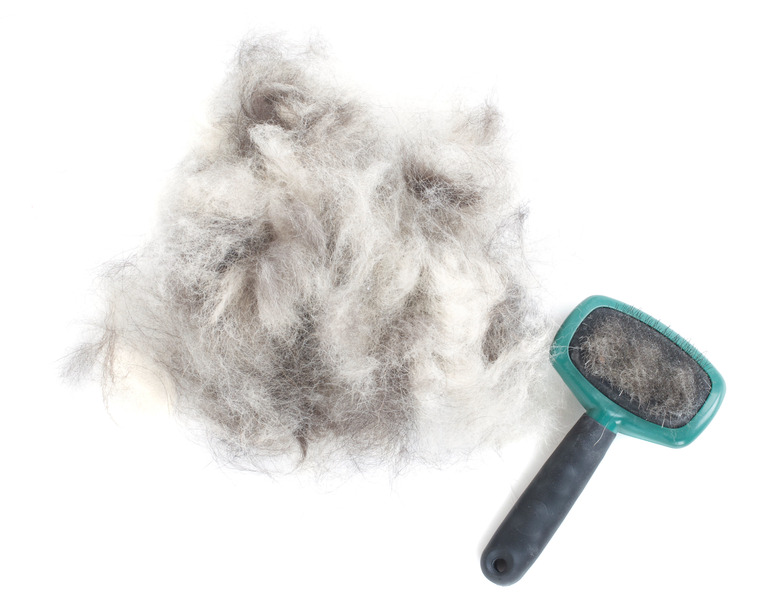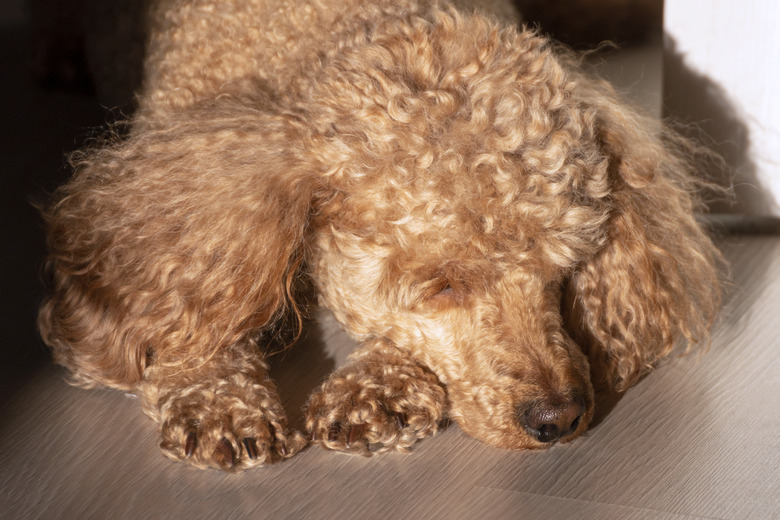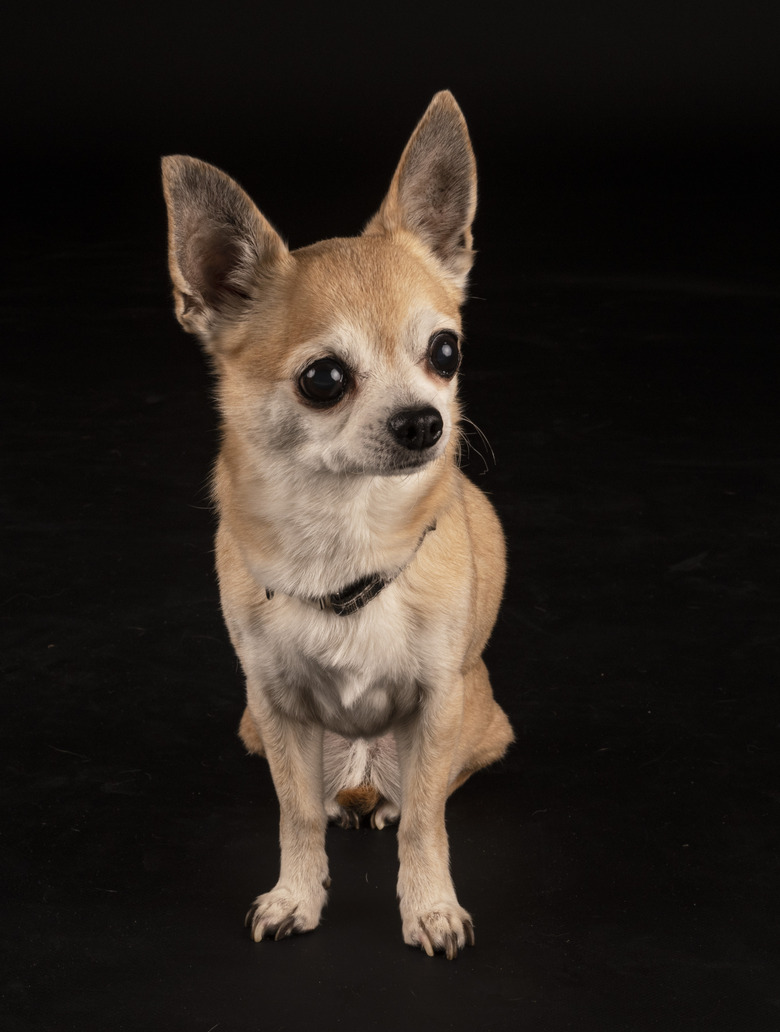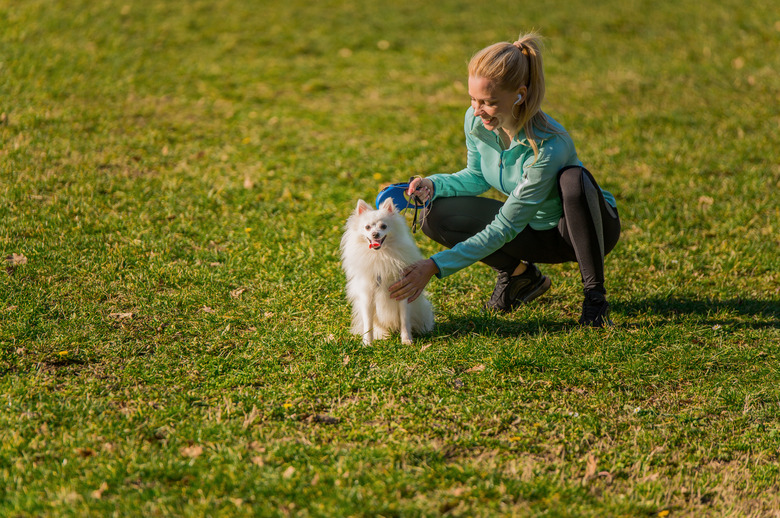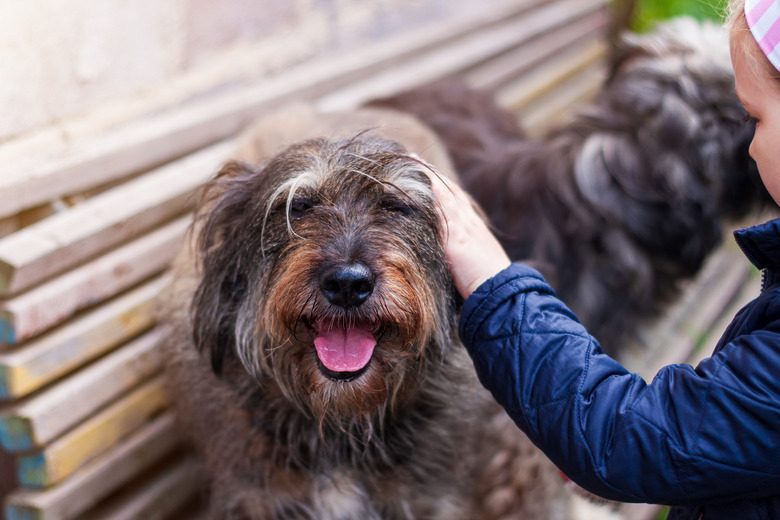Why Is My Dog Shedding In The Middle Of Winter?
We may receive a commission on purchases made from links.
Cuteness may earn compensation through affiliate links in this article.
Some dogs shed seasonally – typically during spring and fall, though in reality, most dogs shed all the time. Shedding is a normal behavior; it's a natural way for a dog to get rid of old, dead hair and replace it with new hair growth. Depending on the type of coat your dog has, their pattern of shedding may vary. Excessive shedding that takes place outside of season could be due to a simple climate change or in some more rare cases it could be a sign of an underlying medical condition.
Types of dog coats that shed
Types of dog coats that shed
Dogs have short hair, long hair, curly hair, flat hair, and single coats and double coats. Genetics has produce dog breeds with many different styles of coats that behave differently. Some breeds have hair that grows continuously and does not shed. Dogs with short, thinner hair don't have the insulating undercoat. These breeds, like Chihuahuas, typically shed all year-round.
Some dogs, such as Afghan hounds, don't shed, according to the AKC, but have such long hair that it needs to be brushed and groomed regularly. Regardless of whether your dog sheds regularly or not, all breeds can benefit from weekly brushing, which removes dead hair and keeps mats from forming.
Others have an outer longer layer of hair and a short, inner layer for insulation. Dogs with an insulating layer of hair are bred for cold climates – think Siberian huskies, Alaskan malamutes, and retrievers. These dogs often shed twice per year depending on the season (late spring and late fall). It's probably not surprising that dogs with two layers of fur shed more often and in more copious amounts than dogs with only one layer.
How dog hair grows
How dog hair grows
Hair grows in cycles. It has a growth stage, a resting stage, and then a stage in which it dies and is ready to fall out. When it falls out, this makes room for new hair growth. The stages of hair growth in dogs is often triggered by light and temperature. Hair grows the most in the summertime, and by the time the new hair growth has reached the end of its life cycle and is ready to fall out, it is typically late fall.
Many other hair follicles enter the resting (non-growth) stage in winter, which produces more copious shedding in the spring. This cycle varies with age and where the hair is on the body. There is not a specific pattern to which hair follicles are resting, growing, or ready to fall out at any given time. It happens across a dog's body in what's known as a "mosaic pattern." This seeming randomness prevents dogs from becoming bald in any single spot.
Reasons for dog shedding
Reasons for dog shedding
Light and climate
Since climate and temperature often trigger shedding in dogs, animals exposed to year-round artificial light (in other words, all of our indoor pets) may also shed all year round. Animals that live outside are exposed to seasonal changes in sunlight and temperature that trigger their seasonal shedding that indoor pets don't get.
Stress and Anxiety
Stress is another factor that contributes to hair loss – it happens with people too. Severe stress causes many hairs to enter the resting phase all at once, causing them to fall out en masse rather than at different times. Depending on the sensitivity of your pet, this type of stress and anxiety can be caused by many different things. Moving to a new house or adding or losing a fellow pet friend can impact your dog. If stress and anxiety could be the cause, keep an eye out for other symptoms, like excessive chewing or licking, or destructive behavior.
Medical Causes for Shedding
Unusual shedding can be an indication of parasites, skin allergies, fungal or bacterial infections or contact with toxic substances. Excess shedding can be an indication of thyroid, kidney, or liver disease or an immune system disorder. It also can be a hormone imbalance. See your vet if your dog is losing hair in patches, which could be a sign of mange or ringworm, or if they have open sore spots or a severe skin irritation. Your vet will take a skin culture and conduct a physical exam to determine the underlying cause of the problem and treat it accordingly.
Maintain a Healthy Coat
Maintain a Healthy Coat
Good nutrition, regular grooming in the form of brushing and occasional bathing, and overall good health will all go a long way toward maintaining a healthy coat and skin. Choose a dog food that promotes a healthy coat. Diamond Naturals Skin & Coat Formula All Life Stages Dry Dog Food is hypoallergenic, packed with protein, and is guaranteed to contain probiotics for digestive support.
If your dog has sensitive skin, they might benefit from Hill's Science Diet Adult Sensitive Stomach & Skin Chicken Recipe Dry Dog Food. This one has prebiotic fiber and generous amounts of vitamin E and omega-6 fatty acids, which research shows helps with skin and coat health. You can boost any food you currently serve your dog with Instinct Freeze-Dried Raw Boost Mixers Grain-Free Skin & Coat Health Recipe Dog Food Topper. This is grain-free, packed with fatty acids, and is a nugget of flavor that you put right on top of their normal food.
In Conclusion
In Conclusion
Hair growth is controlled by genetics, with some dog hair growing until it reaches a certain length. After the growth stage comes a resting stage, followed by a stage in which the hair dies and is ready to fall out to be replaced with new growth. For many dogs, this happens seasonally, in spring and fall. For others, it happens year-round. All dogs will shed at least a little all year long.
Some medical conditions can cause excessive shedding out of season. Look for changes in your dog that could indicate parasites (patchy loss of hair), allergies, or immune system or hormonal disorders. Regardless of the type of hair your dog has or its genetic disposition toward shedding, regular brushing cuts down on the amount of hair that drifts around your house or adheres itself to your furniture.
Always check with your veterinarian before changing your pet's diet, medication, or physical activity routines. This information is not a substitute for a vet's opinion.
